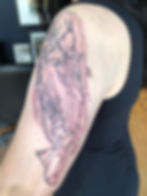Tattoos are as fresh on my mind as the burning sensation on my skin from my most recent inky venture. My half-sleeve in-progress recently became a bit more progressed, and it led me down a rabbit hole (pun-intended… read on for why) of all things tattoo and expressionist-related. I'll start with some personal history.
I was thirty years old when I got my first tattoo. There were three reasons for waiting until this ripe old tattoo-able age before putting ink to skin. The first reason was emotional: I needed a tattoo to symbolize something that would be important to me forever. The second was practical: now, I could tell my daughter that I waited until I was thirty for my first tattoo, so no, she could not have one when she was sixteen. Finally, the third had to do with my own hypochondria; a fear that 15 or so tats and several wonderful artists later have put to significant rest.

When the tattoo conversation comes up, someone inevitably says, “well, they’re addicting.” I’ve been that someone. I’ve made that comment. Yet…
Addicting really isn’t the right concept, at least not for me. I’m not exactly thrilled by the poke of the pin, the uncomfortable hours of positioning, and the itching that follows healing. So, what is it? Why do we love tattoo as a form of self-expression, and is tattoo self-expressionist art? Let’s unpack.
Tattoos Aren’t New
Permanent skin art has been in practice for thousands of years. History tells us that we’ve etched ourselves with symbolism, love declarations, and religious or protective amulets; we’ve also been marked for punishment through means of indelible ink. Carbon dating has shown that a tattooed “Iceman” found in 1991 on the Italian-Austrian border was around 5200 years old. Countless historic sources point towards varied tattoo practices in many ancient and traditional cultures. Today, several cultures continue to adhere to traditional tattooing and marking rituals and practices.
Tattoos in Modern Culture
There’s no doubt that the last century has seen a sharp increase in modern tattoo culture. Stigma is fading. Health and safety are all the rage. Artists are able to showcase their talents on the Internet. Worldwide travel, social media, and tattoo conventions have all made it easy for skin and artists to connect.
Tattoos as Art
We’ve always argued that art is in the eye of the beholder. If you intend for your tattoos to be art, then art they are. What I find fascinating is that tattoos are art that have no secondary buyer market. Tattoos are a visual language, to be displayed at will, to be admired at will, with no discernible monetary value. (Unless someone repurposes my body into a book cover someday, but holy crap, we’re so not talking about that right now.)
There’s no question that the tattooist is referred to as the “tattoo artist.” Tattoos aren’t simply about image, color, or lack of. They’re about placement on the body, flow, and adjacent structures. I remember sitting for a lighthouse tattoo. I wanted a small piece on my wrist. The artist recommended my forearm - a bigger piece - because the design, a vertical structure with intricate lines, warranted a bigger, flatter space. It made sense in relation to the body itself.
Like my own creativity, my tattoo art has evolved. I’ve worked with a number of phenomenal artists over the years, and my tattoo needs have changed. If you follow the evolution, you’ll see that I become more daring over time, with both type, size, and symbolism contained within the art.

Conversely, tattoos don’t need to have reason or flow if you don't prefer that. They can be straightforward or symbolic. Maybe you designed it, or you’re showcasing someone else’s art. It’s usually personal, but it doesn’t have to be. In my experience, most people have stories attached to their tattoos. Perhaps it marks an occasion or a tribute, or something you enjoy. Like art, it's all subjective.
I have tattoos representing my children, but you probably wouldn’t guess that if you looked at the images themselves. Then, there’s a totally inappropriate literary tattoo on my wrist. I have a floral arm (for my dog named Rosie). Most recently, I'm working on a half-sleeve that represents the weirdest rabbit hole I’ve ever envisioned. It’s got a whale with an anatomical heart for a head, a dirtied and torn Alice, a meditating astronaut, a brain in a cloche, a coffee pot, a gravestone, and a metal heart that looks somewhat like computer chip. Don’t try to interpret it. There’s a whole bunch more, but I’m not a museum.
The question that often precedes the one about addiction is if I’m done accumulating body art.

“You know, tattoos are addicting!” They’ll quip, like I can turn back now if I just believe in myself. Enroll in a program. My mom would like that.
“I’m done… for now,” I’ll often reply.
I’m waiting for the next great wave of meaning and symbolism to crest. When it does, I’ll know it; I always do.
A final note about the word ‘parlor…’ since the connotation is strong within the tattoo world. A parlor is definitely my grandparents living room in the early 1980’s, with crushed floral velour fabric on the sofa, red shag carpeting, and the stale smell of cigarettes that lingered in your clothes long after you left. Don’t misunderstand, I loved my grandparents. But, they definitely had a parlor, whereas I hope to convey more of a ‘living room’ in my own home. I also enjoy getting tatted in a studio. Not a parlor.

If you have no regerts, hit that heart! Tell us about your tattoos, your tattoo experiences, or your favorite tattoo stories in the comments below, or support us through the art of caffeine.
